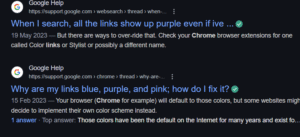In a major privacy-conscious update, Google has said it will shortly be patching a 23-year-old vulnerability in its Chrome browser one that has quietly been lingering in the background for decades. This little-known yet far-reaching flaw let websites know which URLs users had visited in the past by examining how links were rendered on their pages. For example, in brief, the shade of a link—typically purple when you had visited it previously could be utilized to sneak a peek into your browsing past, even when you hadn’t clicked on this link on this particular site.
The problem might seem trivial on the surface, but it is a stark reminder of how discreet features intended for user convenience can inadvertently cause privacy violations. This browser behavior has been an integral part of the web’s design language since the early days of the internet, but only now is it finally receiving the patch it deserves from the world’s most popular browser.
What Was the Bug & Why Does It Matter
Behind it all is styling hyperlinks. When you go to click a link within your browser, the link typically becomes a different color to let you know it’s been visited. This change of color is most often made using the CSS :visited pseudo-class, and with it websites are able to set a style on visited links other than what you get by default, namely they become purple.
But this straightforward feature left a large privacy hole. Sites could take advantage of it by inserting several links usually hidden from the user—and then employ scripts or style detection methods to see which links were styled as “visited.” This would disclose whether a user had visited certain URLs in the past, even if they never clicked on those links on the current page.

This bug basically provided websites with a means of looking at your browsing history. Although it did not directly reveal personal information, it made it possible to perform a kind of digital fingerprinting. For example, a website could see whether you’d visited online banking sites, job search engines, or news websites, and use that information for profiling or targeted advertising.
How Did It Go Unfixed for So Long
Although the privacy consequences of the :visited styling bug have been understood for years, a full solution was elusive. Browser vendors have made piecemeal efforts to limit the exploitability of this behavior. Firefox and Safari, for example, made moves in earlier years to restrict how much styling data can be leaked through visited links.
Chrome and other Chromium-based browsers, though, kept the behavior with some constraints in place. These constraints helped minimize some risk but didn’t completely remove the risk of exploitation. One explanation for the holdup in correcting it could be that the styling behavior is thoroughly ingrained in how browsers render and cache web pages. Modifying this fundamental behavior without breaking functionality for users and developers was always going to be a technical hurdle.
Google’s Fix: The Power of Partitioning
Now, Google is going bold by entirely resolving the problem through a technique known as partitioning. This solution actually isolates the visited state of a link on a per-site basis. That is, whether you’ve clicked on a link or not will only be known to the site where that interaction occurred. If some other entirely different website contains the same link, it won’t be able to access or know about your prior visit to this URL.

It stops cross-site tracking by way of link styling and makes sure that every site has a sandboxed view of your browsing. Partitioning is a more comprehensive technique that’s picking up speed in browser building, particularly as part of privacy-preserving technology like Google’s Privacy Sandbox effort.
Privacy in the Modern Web: A Growing Concern
The fact that such a bug has remained around since the early 2000s just goes to show how privacy wasn’t always a primary concern in the early days of the web. Features were built for convenience like showing users which links they had already clicked without fully considering just how those features could be exploited in a more advanced internet environment.
Now, with increasing concern regarding surveillance, fingerprinting, and behavior tracking, even minor loopholes such as this one gain more importance. Advertisers, data brokers, and even malicious players seek every advantage to monitor users without their consent. Patching up such bugs is important to provide a safer, more private browsing experience.

For regular users, this solution is a privacy win and you don’t have to do anything to take advantage of it. The change will be implemented in a future release of Chrome, and the modification will operate quietly in the background, safeguarding your browsing history without needing manual configurations or add-ons.
Developers, in turn, might have to change the way they implement styling of links. In case a site depends on visited links across sites for legitimate use (like analytics or UX personalization), those methods won’t work as anticipated. Google advises developers not to depend on visited-link styling as a source of data, and instead adhere to privacy-first design practices.
Read Also : Microsoft Warn Users Not To Delete
Another Step Toward a Privacy-First Web
Google’s decision to finally shut this loophole is part of a broader shift across the tech industry. With browser vendors like Apple, Mozilla, and Brave at the forefront of privacy, and with legislation like GDPR and CCPA pressuring businesses to treat user data with care, the web ecosystem as a whole is being transformed.
Splitting visited link history is only one of several future developments. From the elimination of third-party cookies to enhancing sandboxing methods, browsers are being updated to defend users in ways that were not considered a priority in the past. It’s a welcome shift—and overdue.
By fixing a bug that has quietly existed for 23 years, Google is not only enhancing Chrome’s privacy stance but also sending a strong message that the web of the future needs to be built with privacy in mind. As more people wake up to how their data is being used on the web, browser vendors need to step up, not only by introducing new features, but by examining and streamlining the old ones as well.
Even something as small as the color of a link can have significant repercussions. Fortunately, this age-old problem is finally being fixed, and the web is just that little bit more private.

